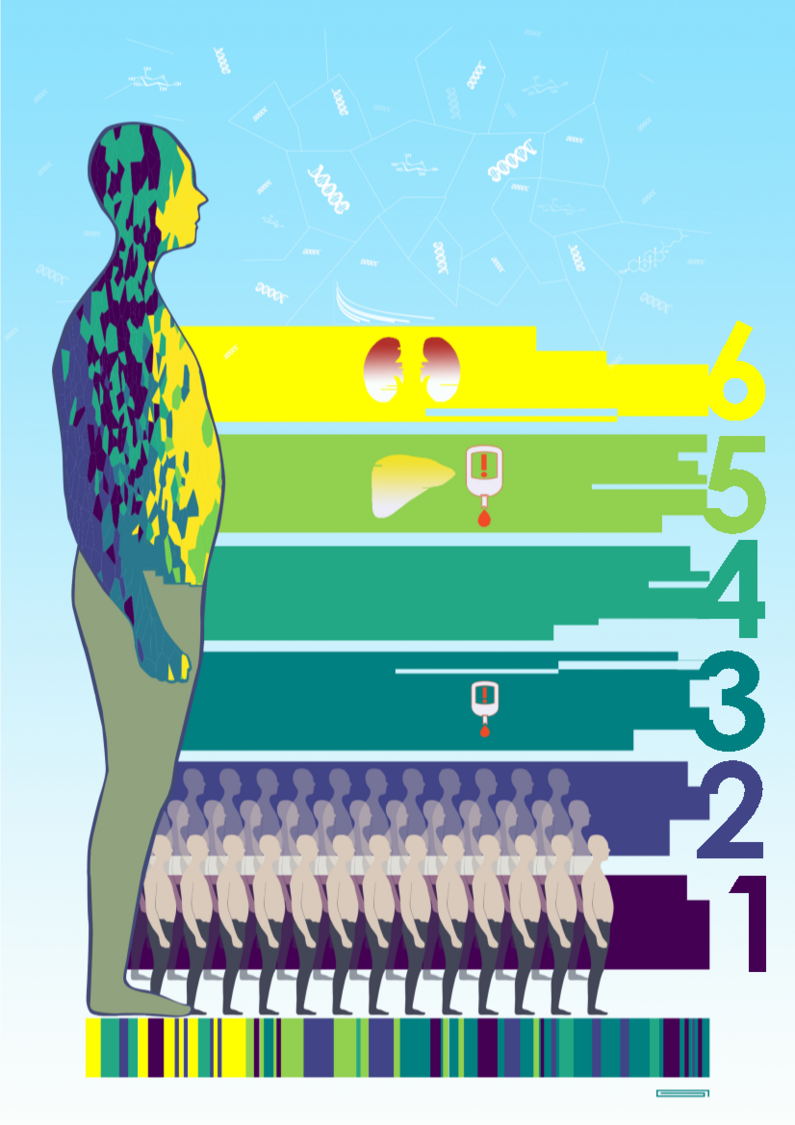Berlin, 10.02.2021
Prediabetes: New Insights into Subtypes Pave the Way for Individual Prevention
Type 2 diabetes is not a disease that develops suddenly. Rather, it usually develops over a period of years from a preliminary stage known as prediabetes. Even if those affected are unaware that they have prediabetes and their blood glucose levels are still below the critical diagnostic threshold, their blood glucose regulation is already slightly impaired in this phase. However, people with prediabetes are not a homogeneous group, as physicians from Tübingen University Hospital, the Institute for Diabetes Research and Metabolic Diseases (IDM) of Helmholtz Zentrum München at the University of Tübingen and the German Center for Diabetes Research (DZD) show in the journal Nature Medicine. Within the scope of a long-term study, they identified six subtypes of prediabetes that differ significantly in terms of risk factors, disease development and prognosis. According to the German Diabetes Society (DDG) and the DZD, this could result in important approaches for individually adapted preventive and therapeutic measures.
A lifestyle involving little physical exercise, mainly sedentary activity, an unbalanced diet and overweight is considered to be the cause of type 2 diabetes. For decades, the number of affected people has been rising worldwide; in Germany alone, more than eight million people are now affected by this serious metabolic disorder. "However, how long it takes for prediabetes to develop into manifest diabetes and how high the risk is for secondary diseases vary greatly from patient to patient," said Professor Robert Wagner of Tübingen University Hospital. He based his research on data gained from subjects of the Tübingen Family Study and the Tübingen Lifestyle Program (TULIP), which Professor Hans-Ulrich Häring initiated 25 years ago, to understand the causative disease mechanisms for diabetes. Study participants at high risk for diabetes regularly underwent clinical examinations, laboratory tests, and magnetic resonance imaging to determine their phenotype. "In addition to parameters of glucose metabolism, insulin secretion and sensitivity were now also measured, and body fat distribution, blood lipid levels and genetic factors were analyzed," said Wagner, explaining the methodological approach of the long-term study.
The data from the approximately 900 subjects served as the basis for a so-called cluster analysis. The result was clear: "Six subtypes emerged among the subjects, which differed significantly with regard to their individual risk factors and the further course of the disease – i.e. the development of manifest diabetes and the risk of secondary diseases," said one of the study leaders, Professor Andreas Fritsche. For example, not every person who is overweight automatically runs the risk of developing manifest diabetes. "It is the combination of individual parameters such as body fat distribution or insulin sensitivity which makes a clearer assessment possible. We found that blood glucose values alone, on which the diagnosis of prediabetes or diabetes is usually based, are not sufficient to make predictions about a later manifestation of diabetes in the test subjects," said study leaders Häring and Fritsche. The study clearly shows how important it is to include other parameters besides blood glucose levels for risk assessment. "Building on these groundbreaking results, we will investigate the mechanisms in the high-risk clusters and pursue research on tailored therapy strategies in the future," said Professor Andreas Birkenfeld, medical director of the Department of Diabetology, Endocrinology and Nephrology at Tübingen University Hospital and DZD spokesperson.
For the DDG and the DZD, these new findings are also the basis for further prospective studies. "It is of immense importance to continue investigating the early phase of the metabolic disease – also in view of the further increasing numbers of diabetes patients. Only then can individually tailored prevention and therapy measures be developed and initiated," said DDG President Professor Monika Kellerer. "The results are an important step towards precision medicine. We are continuing to work on this in the DZD," said DZD board member Professor Martin Hrabě de Angelis. The current study also exemplifies how important it is to combine biochemistry with bioinformatics and university clinical research – ultimately for the benefit of patients.
Original publication:
Wagner, R., Heni, M., Tabák, A.G. et al. Pathophysiology-based subphenotyping of individuals at elevated risk for type 2 diabetes. Nat Med 27, 49–57 (2021). doi.org/10.1038/s41591-020-1116-9
About the German Diabetes Society (DDG):
With more than 9200 members, the German Diabetes Society (DDG) is one of the major medical and scientific societies in Germany. It supports science and research, is involved in continuing education and training, certifies treatment facilities and develops guidelines. Its goal is more effective prevention and treatment of diabetes, a widespread disease that affects more than eight million people in Germany. To this end, it also undertakes extensive health policy activities. www.deutsche-diabetes-gesellschaft.de
About the German Center for Diabetes Research (DZD)
The German Center for Diabetes Research (DZD) is one of six German Centers for Health Research. It brings together experts in the field of diabetes research and combines basic research, epidemiology and clinical application. By adopting a novel, integrative approach to research, the DZD aims to make a substantial contribution to the successful, personalized prevention, diagnosis and treatment of diabetes mellitus. The members of the association are Helmholtz Zentrum München – German Research Center for Environmental Health, the German Diabetes Center (DDZ) in Düsseldorf, the German Institute of Human Nutrition (DIfE) in Potsdam-Rehbruecke, the Institute of Diabetes Research and Metabolic Diseases of Helmholtz Zentrum München at the University of Tübingen, and the Paul Langerhans Institute Dresden of Helmholtz Zentrum München at the University Medical Center Carl Gustav Carus of TU Dresden, associated partners at the universities in Heidelberg, Cologne, Leipzig, Lübeck and Munich, as well as other project partners. www.dzd-ev.de/en
Contact:
Press office DDG
Michaela Richter/Bettina Rackow-Freitag
Postfach 30 11 20, 70451 Stuttgart
Tel.: +49 (0)711 8931-516/-640, Fax: +49 (0)711 8931-167
richter(at)medizinkommunikation.org
freitag(at)medizinkommunikation.org
Press contact

Birgit Niesing
niesing(at)dzd-ev.de
+49 (0)89 3187-3971

